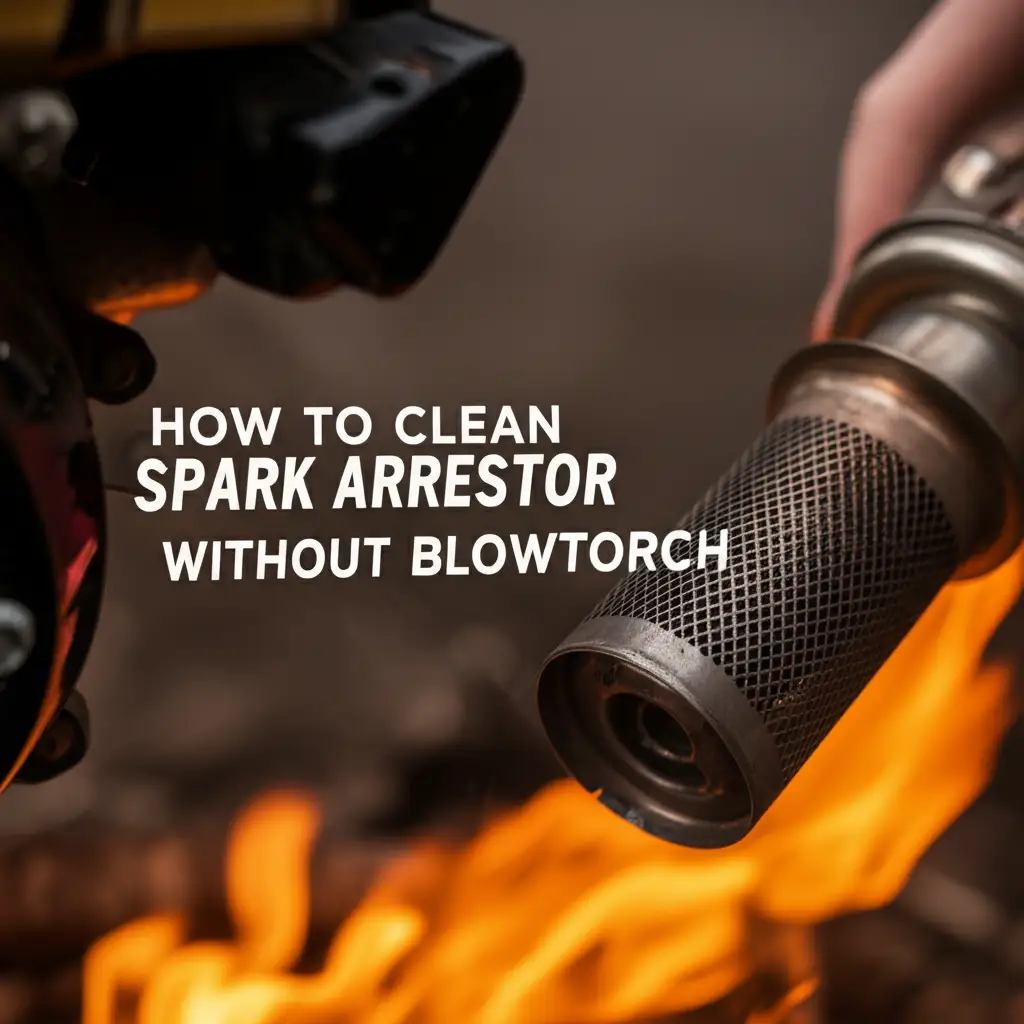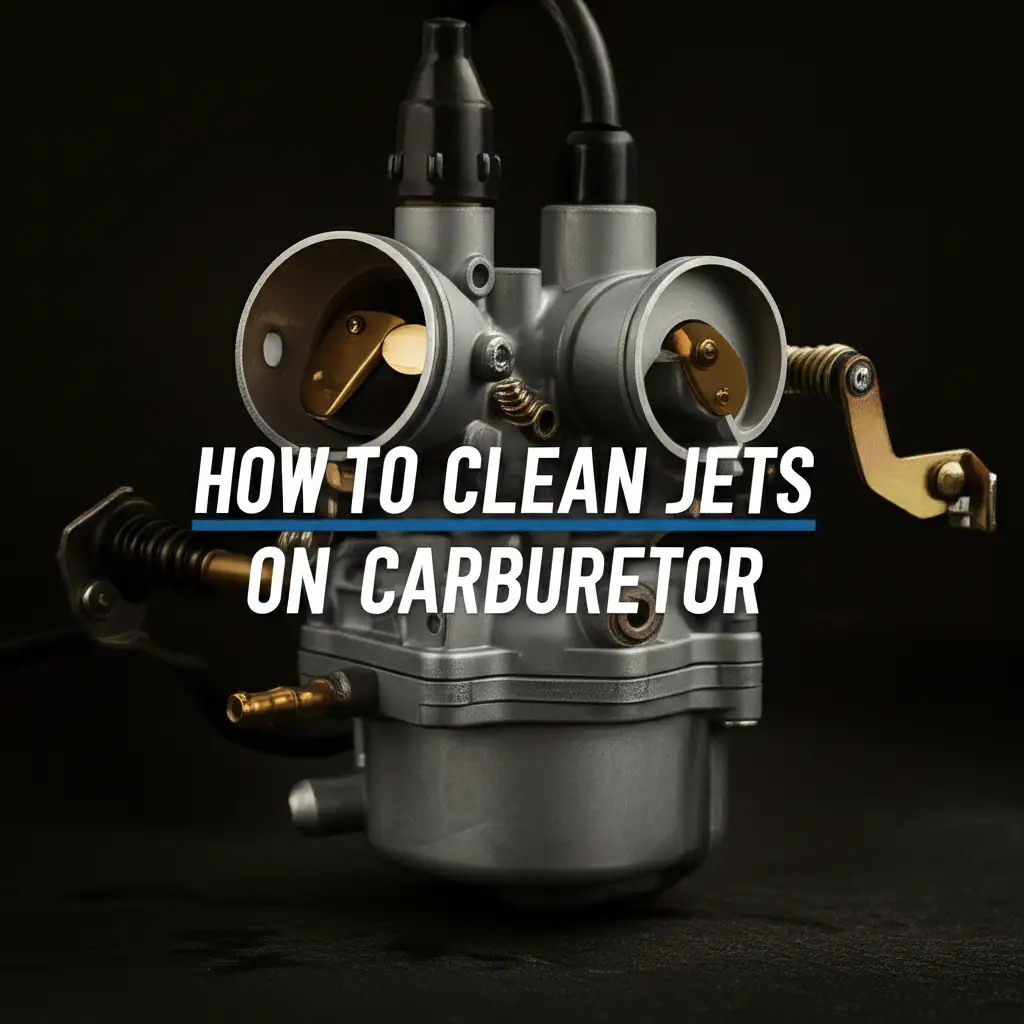· Small Engine Maintenance · 17 min read
How To Clean Spark Arrestor Without Blowtorch

Effective Ways to Clean Your Spark Arrestor Without a Blowtorch
Have you noticed your small engine losing power? Maybe it struggles to start or runs rough. Often, the culprit is a clogged spark arrestor. This small but vital component collects carbon buildup, restricting exhaust flow. Many people consider using a blowtorch for cleaning, but this approach carries risks. I want to show you safer, more effective methods to clean spark arrestor without blowtorch.
Understanding how to clean this part properly ensures your equipment runs smoothly and safely. A clean spark arrestor also prevents potential fire hazards. This article will guide you through various methods. We will discuss the right tools and materials you need. You will learn step-by-step processes to restore your spark arrestor to peak condition. My goal is to equip you with the knowledge for successful, torch-free maintenance.
Takeaway
- Avoid blowtorches for spark arrestor cleaning due to safety risks and potential damage.
- Use non-flammable solvents and mechanical brushing for effective carbon removal.
- Regular cleaning prevents power loss, starting issues, and fire hazards in small engines.
- Always disconnect the spark plug and allow the engine to cool before starting work.
- Implement preventative measures to reduce future carbon buildup.
Clear and Concise Answer to Main Query
You can clean a spark arrestor effectively without a blowtorch by using a combination of soaking in a carbon-dissolving solvent, vigorous wire brushing, and scraping. This method safely removes carbon deposits, restores proper exhaust flow, and avoids the risks associated with open flames. Always ensure the engine is cool and the spark plug is disconnected before you begin.
Understanding Your Spark Arrestor and Its Purpose
Every small internal combustion engine, from your chainsaw to your lawnmower, likely has a spark arrestor. This device sits inside the muffler or exhaust system. Its main job is to prevent hot carbon particles, or “sparks,” from leaving the exhaust. These sparks can ignite dry tinder or other flammable materials. Spark arrestors are crucial for safety, especially when using equipment in dry conditions or forested areas. Many laws require them on outdoor power equipment.
The spark arrestor is typically a fine mesh screen or a series of baffles. Exhaust gases flow through this screen. As gas passes, it cools and traps any burning carbon bits. Over time, these trapped carbon particles accumulate. They form a hard, black buildup on the screen. This buildup narrows the exhaust passage. A clogged spark arrestor restricts exhaust flow, which harms engine performance. Your engine might lose power, struggle to start, or even overheat. Regular cleaning maintains engine efficiency and reduces fire risk.
Ignoring a dirty spark arrestor leads to various problems. Engine performance degrades slowly, often unnoticed at first. You might experience reduced RPMs or less cutting power. Fuel efficiency also decreases as the engine works harder. In severe cases, the engine might not start at all. The increased back pressure can also put strain on other engine components. This includes valves and the piston. A neglected spark arrestor is not just a nuisance; it is a safety concern and a direct cause of premature engine wear. Therefore, understanding its function and maintaining it is a fundamental part of equipment care. I always check mine, especially before fire season.
Why Avoid a Blowtorch for Spark Arrestor Cleaning
Many people think a blowtorch is a quick fix for a clogged spark arrestor. The idea is to burn off the carbon buildup. However, I strongly advise against using a blowtorch for this task. There are significant risks involved. First, using an open flame near engine components is extremely dangerous. Fuel residues can remain in the exhaust system, even if you drain the tank. These residues can ignite, causing a fire or even an explosion. You risk serious injury to yourself and damage to your equipment.
Second, a blowtorch applies intense, localized heat. This extreme heat can warp or melt the delicate mesh screen of the spark arrestor. The screen is often made of thin steel or other metals. These materials are not designed to withstand direct flame. If the screen deforms, it will no longer function correctly. A damaged screen might allow sparks to escape. This defeats the entire purpose of the spark arrestor. Replacing a damaged spark arrestor is more costly than simply cleaning it properly. The heat can also damage the muffler itself, leading to cracks or weakened welds.
Furthermore, direct heat can harm surrounding components. The muffler is often close to plastic housing, rubber seals, or wiring. These parts will melt or degrade under high heat. You might also damage the paint or finish on the muffler. The fumes from burning off carbon can also be toxic. Inhaling these fumes is harmful to your health. Using a blowtorch might seem fast, but it is risky, potentially damaging, and unnecessary. Safer, more effective methods exist to clean your spark arrestor. I prefer methods that protect both me and my equipment.
Essential Tools and Materials for Safe Cleaning
Before you start cleaning your spark arrestor, gather the right tools and materials. Having everything ready saves time and ensures a smooth process. You will need basic hand tools to remove the muffler or spark arrestor cover. A wrench or a screwdriver set will usually suffice. The specific tools depend on your equipment model. Always check your equipment’s manual for specific instructions on accessing the spark arrestor. Safety glasses are a must to protect your eyes from debris. Thick gloves are also important to protect your hands.
For the actual cleaning, you will need a stiff wire brush. A small brass or steel brush, like those used for cleaning battery terminals or welding, works well. A pick or a small flat-head screwdriver is useful for scraping away stubborn carbon deposits. For soaking, you will need a metal container or a sturdy plastic tub. Choose one large enough to submerge the spark arrestor completely.
Regarding cleaning solutions, several options work effectively.
- Carburetor Cleaner: This solvent is designed to dissolve carbon and fuel residues. It is highly effective. Ensure you use it in a well-ventilated area.
- Oven Cleaner: Many oven cleaners contain strong degreasers that break down carbon. Look for a heavy-duty, fume-free type.
- Degreaser: General-purpose engine degreasers can also help. They loosen grease and carbon.
- Simple Green or other concentrated household cleaners: Diluted solutions can sometimes help soften lighter deposits, but may not be strong enough for heavy buildup.
- White Vinegar and Baking Soda: While excellent for many cleaning tasks around the house, like when you how to clean oven with baking soda, their effectiveness on hardened carbon in a spark arrestor is limited compared to chemical solvents. They work by chemical reaction to lift grime, but spark arrestor carbon is very dense.
Always read the labels of any chemical cleaners. Follow safety warnings carefully. Ensure you have good ventilation. I always use a respirator if I’m working with strong solvents. A clean rag or paper towels are also helpful for wiping down parts.
Step-by-Step Guide: The Soaking and Brushing Method
This method is highly effective for cleaning your spark arrestor without a blowtorch. It relies on dissolving the carbon buildup and then mechanically removing it. Follow these steps carefully for the best results.
1. Preparation and Disassembly
First, make sure your engine is completely cool. Never work on a hot engine. Locate the spark plug and disconnect its wire. This prevents accidental starting. Now, locate the muffler on your equipment. You might need to remove a protective cover to access the spark arrestor. On some models, the spark arrestor is a separate screen you can pull out. On others, it might be integrated into the muffler outlet. Consult your equipment’s user manual for specific instructions on how to access and remove the spark arrestor. Use your wrench or screwdriver to carefully unbolt or unscrew the necessary components. Take note of how parts fit together. You will need this for reassembly. Once the spark arrestor or muffler is free, set it aside.
2. Initial Scraping and Brushing
Before soaking, remove as much loose carbon as possible. Use a small pick or a flat-head screwdriver. Gently scrape the carbon off the mesh screen. Be careful not to puncture or damage the screen. Carbon buildup can be quite brittle, so it may chip away easily. After scraping, use a stiff wire brush. Scrub the spark arrestor vigorously. Get into all the nooks and crannies. This initial brushing removes the superficial layers of carbon. It also helps expose the deeper, more stubborn deposits to the cleaning solution. Work over a trash can or a protected surface. Carbon dust can be messy.
3. Soaking the Spark Arrestor
Now, it is time to soak the spark arrestor. Place the spark arrestor into your metal or sturdy plastic container. Pour your chosen cleaning solution over it. Carburetor cleaner or a heavy-duty oven cleaner works best. Ensure the spark arrestor is fully submerged. Let it soak for several hours. For heavily clogged arrestors, an overnight soak can be very beneficial. The solvent will penetrate and soften the hard carbon deposits. This makes them much easier to remove. I often leave mine soaking overnight. Check the cleaner’s instructions for recommended soaking times.
4. Final Brushing and Rinsing
After soaking, remove the spark arrestor from the solution. Wear gloves. The carbon should now be much softer. Use your wire brush again. Scrub the screen thoroughly. You should see more carbon flaking off easily. Use the pick or screwdriver for any remaining stubborn spots. Ensure all holes in the mesh are clear. You should be able to see light through the screen. Once satisfied, rinse the spark arrestor thoroughly with water. Rinse until all cleaning solution and carbon residue are gone. Some people prefer using a high-pressure nozzle if available.
5. Drying
Allow the spark arrestor to dry completely before reinstallation. You can air dry it. Placing it in direct sunlight helps speed up the process. Alternatively, use compressed air to blow out any remaining moisture. Ensure no water remains inside the mesh. Moisture can lead to rust or cause starting issues if reinstalled wet. A completely dry spark arrestor prevents future problems.
Alternative Cleaning Methods for Stubborn Buildup
Sometimes, soaking and brushing are not enough for extremely stubborn carbon. For these situations, alternative methods can provide extra cleaning power. These methods often involve stronger chemicals or more specialized tools. Always prioritize safety when using these approaches. Ensure proper ventilation and wear personal protective equipment.
1. Chemical Carbon Removers
Beyond standard carburetor cleaners, specialized carbon removers exist. These are often industrial-strength solvents designed for heavy-duty applications. They penetrate very hard carbon deposits more effectively. Follow the product instructions precisely. These chemicals can be harsh, so avoid skin contact. Ensure you use them in an outdoor area or a workshop with excellent airflow. After soaking, follow up with the wire brush and rinse as before. These products are usually found at auto parts stores or small engine supply shops. They are a good investment for persistent carbon issues.
2. Ultrasonic Cleaning
For those who want a truly deep clean, an ultrasonic cleaner is an option. These devices use high-frequency sound waves. The waves create microscopic bubbles in a cleaning solution. These bubbles implode, creating a scrubbing action that cleans intricate parts. You place the spark arrestor into the ultrasonic cleaner’s tank. Fill the tank with a suitable cleaning solution, often just water with a mild degreaser. Turn on the machine. The ultrasonic waves will vibrate off the carbon deposits. This method is very effective for getting into tiny mesh holes. It also causes no mechanical damage. Ultrasonic cleaners are an investment, but they are great for small, intricate parts.
3. Baking Soda Paste (Limited Effectiveness)
While less aggressive, a baking soda paste can sometimes help with lighter carbon buildup. Mix baking soda with a small amount of water to form a thick paste. Apply this paste directly to the spark arrestor screen. Let it sit for several hours. The abrasive nature of baking soda combined with its mild alkalinity may help loosen some deposits. After soaking, scrub with a wire brush. This method is non-toxic and eco-friendly. However, it is generally not powerful enough for heavy, baked-on carbon. I find it better for lighter, regular cleaning rather than deep restoration. It’s useful for general cleaning, like when you want to how to clean shower with baking soda, but not always for stubborn engine carbon.
Reassembly and Post-Cleaning Checks
Once your spark arrestor is clean and dry, it is time to put everything back together. Proper reassembly is crucial for safe and efficient operation. This step also involves checking related engine components. A thorough inspection ensures your maintenance work translates into improved performance.
1. Reinstalling the Spark Arrestor
Carefully place the clean spark arrestor back into its position. Refer to your earlier notes or the equipment manual. Ensure it fits snugly. If there are gaskets, make sure they are in good condition and seated correctly. Gaskets prevent exhaust leaks. Tighten any screws or bolts securely. Do not overtighten, as this can strip threads or damage components. Reattach any protective covers that you removed earlier. Double-check all fasteners. You want everything to be tight and secure before operating the engine.
2. Checking Related Engine Components
After reassembling the spark arrestor, it is a good time to inspect other parts of your engine. Look at the muffler itself. Check for any cracks or damage. Ensure there are no loose parts. A leaky muffler reduces engine power and increases noise. Also, inspect your spark plug. Carbon buildup on the spark arrestor often means other engine parts might also have carbon. A dirty spark plug can cause starting problems or rough running. You can often clean spark plugs without removing them using specific techniques. Sometimes, a quick spray with a product like WD-40 can help clean terminals; for specific guidance on this, learn how to clean spark plugs with WD40. For lawnmowers, specifically, knowing how to clean lawn mower spark plug can be very useful after muffler maintenance.
3. Reconnecting the Spark Plug and Testing
Finally, reconnect the spark plug wire firmly to the spark plug. Make sure it clicks into place. This connection provides the necessary spark for ignition. Once everything is reassembled and checked, you can start your engine. Listen for any unusual noises. Observe how the engine runs. It should start more easily. It should also run more smoothly and powerfully. You might notice a significant improvement in performance. If it does not run well, recheck your work. Ensure all connections are secure. Sometimes, a brief period of running helps clear any remaining fine particles from the exhaust system. This post-cleaning test confirms your efforts have paid off.
Preventative Maintenance for Your Spark Arrestor
Cleaning your spark arrestor is vital, but preventing excessive carbon buildup is even better. Regular preventative maintenance extends the life of your spark arrestor and your engine. It also reduces the frequency of deep cleaning. A few simple practices can make a big difference.
1. Use the Right Fuel and Oil Mixture
Small engines, especially 2-stroke models, rely on a precise fuel and oil mixture. Using the wrong ratio can cause problems. Too much oil can lead to excessive carbon buildup in the combustion chamber and exhaust system. Too little oil can cause engine damage due to lack of lubrication. Always use the manufacturer’s recommended fuel-to-oil ratio. High-quality, fresh fuel is also important. Stale fuel can leave behind residues. Using ethanol-free fuel, if possible, can also reduce carbon deposits. I always buy fresh fuel for my chainsaw.
2. Operate at Proper Engine Speeds
Running your small engine at very low RPMs for extended periods can contribute to carbon buildup. Engines are designed to operate within a specific RPM range for optimal combustion. At low speeds, combustion may not be complete. This leaves unburnt fuel and oil. These unburnt particles can deposit as carbon in the exhaust. Occasionally, run your engine at higher, but safe, operating speeds. This helps burn off some of the softer deposits. Do not over-rev the engine, but ensure it reaches its designed operating temperature and speed.
3. Regular Engine Servicing
A well-maintained engine produces less carbon. Follow your equipment’s recommended service schedule. This includes checking and replacing air filters. A dirty air filter restricts airflow. This leads to a rich fuel mixture and incomplete combustion. Change your spark plug regularly. A worn or fouled spark plug can also cause incomplete combustion. Keep your carburetor tuned correctly. A properly tuned engine burns fuel more efficiently. This reduces the amount of carbon expelled into the exhaust system. These practices combine to reduce the load on your spark arrestor.
4. Brief, Regular Inspections
Make a habit of performing quick checks on your spark arrestor. Before each use, or at least seasonally, quickly inspect the visible part of the spark arrestor. If you notice a thin layer of soot, a quick brush with a wire brush can remove it before it hardens. This prevents heavy buildup. Early intervention means less effort later. It is much easier to brush off loose carbon than to soak and scrape hardened deposits. Incorporating these simple habits into your routine will keep your spark arrestor cleaner for longer.
Frequently Asked Questions
Q1: How often should I clean my spark arrestor?
A1: The cleaning frequency depends on engine use and fuel quality. For occasional use, clean it annually. For frequent or heavy use, especially with older engines or non-premium fuel, clean it every 25-50 hours of operation. Check it regularly if you notice power loss or starting issues. I check mine before each heavy use season.
Q2: Can a clogged spark arrestor damage my engine?
A2: Yes, a clogged spark arrestor can damage your engine. It creates back pressure, which can strain internal components like valves and pistons. This leads to overheating, reduced engine life, and premature wear. It also decreases fuel efficiency and overall performance.
Q3: What if I can’t remove the spark arrestor screen?
A3: Some spark arrestors are not easily removable. In these cases, you might need to remove the entire muffler assembly. Then, you can soak and clean the muffler with the screen attached. Alternatively, spray carburetor cleaner directly into the muffler outlet, letting it soak, and then using a wire brush tool.
Q4: Is it safe to use brake cleaner instead of carburetor cleaner?
A4: Brake cleaner can sometimes dissolve carbon, but it is typically not as effective as dedicated carburetor cleaners for baked-on carbon. Brake cleaner often evaporates very quickly, which limits its soaking action. Always check the product’s safety data sheet. Carburetor cleaner is designed for this specific task.
Q5: Will a clean spark arrestor improve fuel efficiency?
A5: Yes, a clean spark arrestor significantly improves fuel efficiency. A clogged arrestor restricts exhaust flow, causing the engine to work harder. This wastes fuel. By restoring proper exhaust flow, the engine operates more efficiently. You will notice better power and use less fuel.
Q6: What does the spark arrestor look like on a chainsaw?
A6: On most chainsaws, the spark arrestor is a small, fine mesh screen located inside or directly behind the muffler’s exhaust port. You usually need to remove a small cover or a couple of screws on the muffler to access it. It appears as a small, circular, or rectangular screen.
Conclusion
You now have a clear path to clean spark arrestor without blowtorch. We covered the critical role of this small component in engine safety and performance. You also learned why a blowtorch poses unnecessary risks and how safer, more effective methods exist. By using solvents, brushes, and a little patience, you can thoroughly clean carbon buildup. Remember, regular maintenance extends the life of your equipment and prevents frustrating breakdowns.
I encourage you to implement the soaking and brushing method for your small engine equipment. Pay attention to safety, and always ensure your engine is cool and disconnected. Don’t forget to incorporate preventative measures into your routine. Using the right fuel and performing regular checks will keep your spark arrestor clean for longer. A well-maintained spark arrestor means a safer, more powerful, and longer-lasting engine. Take action today to keep your equipment running at its best!
- spark arrestor cleaning
- no blowtorch
- small engine maintenance
- carbon removal
- DIY cleaning
- outdoor power equipment
- muffler cleaning




